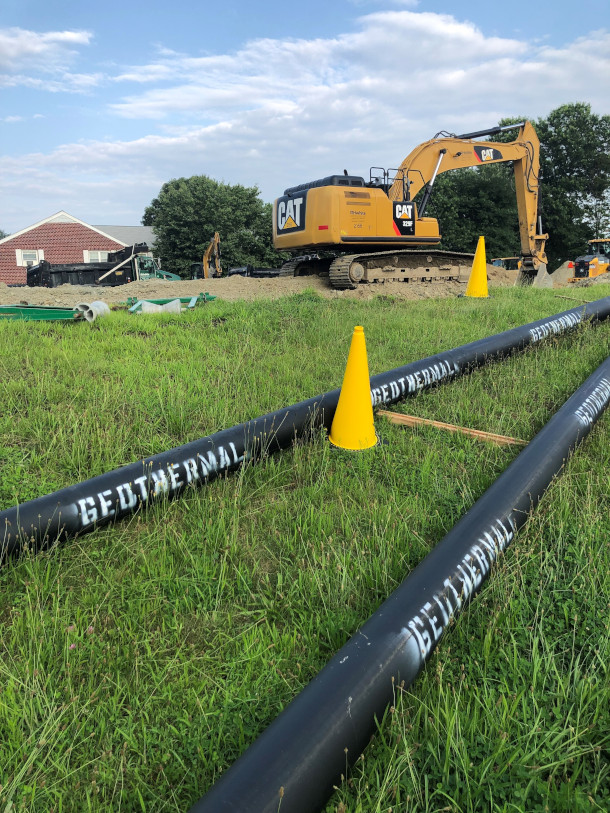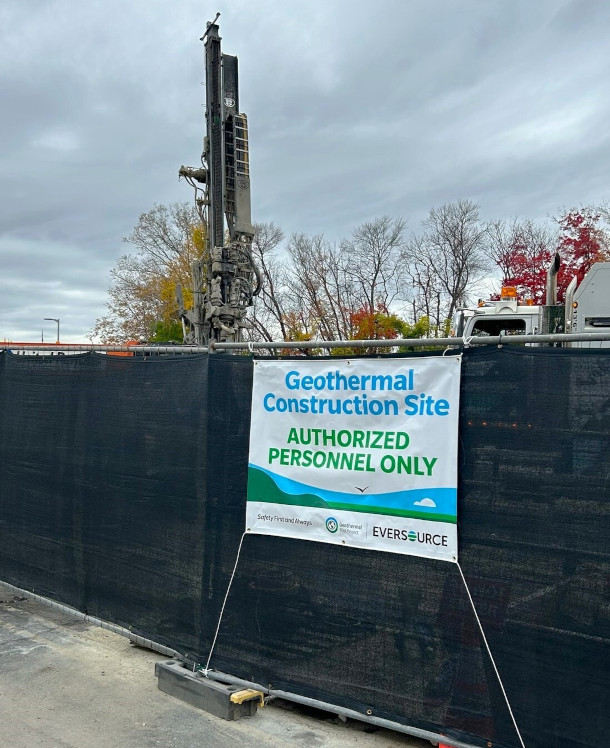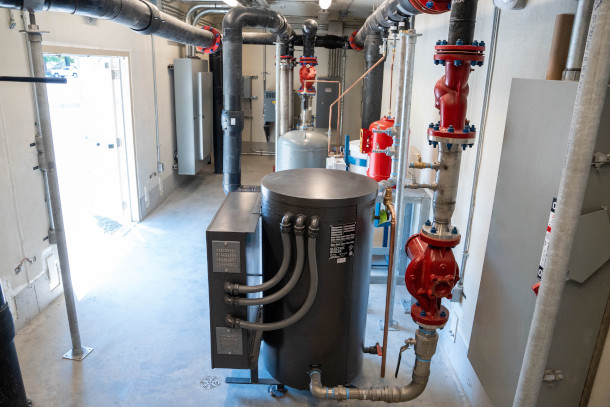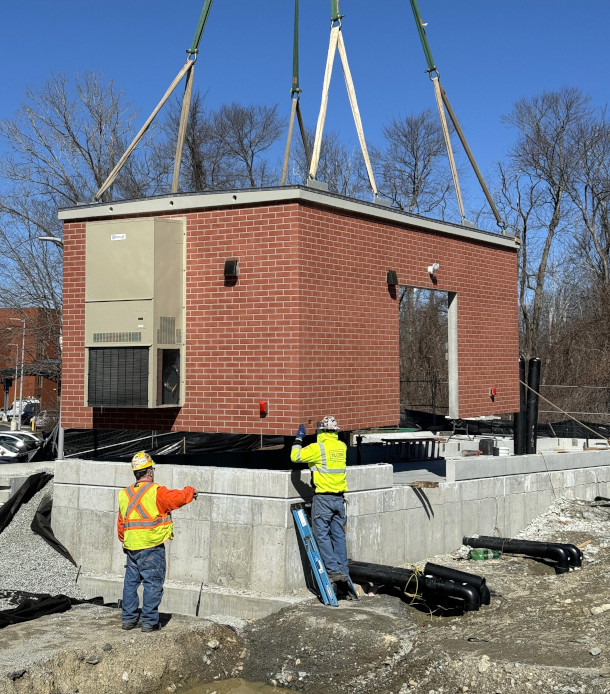Fighting Climate Change with Geothermal Networks
Air Date: Week of April 18, 2025

Geothermal energy harnesses the natural heat from underground. (Photo: Provided by Eversource)
Using the Earth’s heat as an anchor for heat pumps yields virtually carbon-free energy. In contrast with intense deep geothermal heat, surface geothermal projects tap into the relatively constant temperature of the close to-the-surface earth, which sits around 55 degrees. The process is more efficient than air-coupled heat pumps, providing new hope for combatting the climate crisis. Phil Mckenna is a reporter with Living on Earth’s media partner Inside Climate News, and he joined host Steve Curwood to discuss the prospect of geothermal networks.
Transcript
BELTRAN: One sign of hope for the climate crisis may be geothermal energy. You may have heard about deep geothermal, like the plants in Iceland that typically involve wells up to 5,000 meters and can extract heat up to 200 degrees Celsius, producing steam to make electricity. But there’s also shallow or surface geothermal which goes down 500 meters or less and taps into the relatively constant temperature of the close-to-the-surface earth, which sits around 55 degrees.
CURWOOD: Shallow ground source heat pump systems circulate fluids into that 55 degrees and bring them up to condensers that extract heat during cold weather months and send heat underground during the hot summer. The process is more efficient than air-coupled heat pumps, And according to the US Department of Energy, geothermal has the potential to heat and cool tens of millions of homes. But the up-front costs are large, so pilot projects like one in Framingham, Massachusetts are using the deep pockets of gas utilities to build geothermal networks that collect affordable payments from individual customers over time. Phil McKenna is a journalist with our partner Inside Climate News and he’s been covering shallow geothermal projects across the states.
Hi Phil welcome back!
MCKENNA: Thanks for having me.
CURWOOD: So how big a deal are these shallow geothermal systems here in the United States? How many homes are using these things?
MCKENNA: I think there's about 1 million now. But there was a recent report that came out by the US Department of Energy that said by 2035 these could be in 7 million homes, heating and cooling 7 million homes across the country, by mid-century, 36 million homes. They've been around for a while. The technology isn't new. What is new is a new business model where gas utilities, of all people, are really getting behind this and using it as a way to transition off of fossil fuels. And by doing so, they are able to ramp up from one off homes, doing this to entire neighborhoods, decarbonizing all at once.

Eversource, a natural gas company, is investing in geothermal as a way to diversify its business model. (Photo: Provided by Eversource)
CURWOOD: Wait a second. I mean gas utilities. I mean, one would say that trying to get rid of fossil fuels means that gas utilities will be going away. What's in it for gas utilities to get involved with shallow geothermal?
MCKENNA: Here in Massachusetts, the state has told utilities that by 2050 there's going to be no more burning gas for heating, so you either have to find a different business model or go out of business. And something really interesting happened a few years back where climate advocates here in Massachusetts, who had previously been just at the throats of the gas companies, really calling them out for all the gas leaks. Methane, as you know, primary component of natural gas, if a little bit of it leaks on the way to an end user, it has a tremendous climate impact. So the advocates were calling them out for their gas leaks and really butting heads with the industry, really not getting anywhere on reducing those emissions. And then there was a key moment where three advocates, three women, sat down with three executives, three men from a gas utility, and they started to have a conversation. And it started when one of the advocates, Zeyneb Magavi, now the executive director of HEET, said, "You know, look, we're not here to attack you, but we have children, and we're concerned about their future." And there's kind of this awkward pause, and the guest executive who just moments before the meeting had been asked, you know, do you want attorneys present? Do you need a security detail? He declined both of those, and he responded to the advocacy said, "You know, look, I have kids too, and I'm concerned about their future as well." And that allowed for a conversation to start and slowly, over time, there was a lot of trust building, working on actually going after gas leaks. But then it led to this other system where gas utilities would be transitioning off of gas entirely.
CURWOOD: So talk to me about the networks here. What is the geothermal energy network that the gas company would be installing and who plugs into it?

Even though geothermal energy is cheap to run, the startup cost necessary to retrofit homes to accommodate it can be expensive. (Photo: Provided by Eversource)
MCKENNA: Right, so if the simplest system is a ground source heat pump, where you as an individual, at your home, you drill a borehole or a well to tap into that underground heat and then have a heat pump connected to your home. When you combine it in a network, in the case of Framingham, something like 31 buildings and approximately 130 individual customers all connected to this network. So a large bore field, large number of wells, and then about a mile loop connecting all the buildings. When you connect as a network, you get increased efficiency, and that has to do primarily with the different heating and cooling needs of different buildings. So a classic example would be a grocery store or an ice rink has tremendous cooling needs year-round. So they're going to be even in the winter, they're going to be dumping a lot of heat out of their building to cool down that ice or that refrigerated section. And if you pair that with residential that has a lot of heating needs in the winter, you can push and pull heat between them for additional thermal savings.
CURWOOD: So what's the big picture here? How much geothermal energy can be built out across the United States? How about around the world?
MCKENNA: Yeah, so around the US, that liftoff report that the DOE put out at the end of the Biden Administration, saying, I think 36 million homes by 2050. Around the world is really interesting in that a member of the World Bank, the International Finance Corporation, is really looking at geothermal networks in a big way and hoping to provide funding to countries across the Middle East and Central Asia, including Pakistan, Jordan, Turkey, trying to get, I believe, about 10,000 home equivalents in each country on these geothermal networks as an alternative to fossil fuels.
CURWOOD: Phil these are really contentious and difficult times. What does this story tell us about the ways that we can move forward in the face of the climate emergency and, frankly, some of our social and political issues?

Clean energy activists and Eversource representatives found common ground when discussing wanting a better future for their children. This led to Eversource investing in geothermal in Framingham, MA. (Photo: Provided by Eversource)
MCKENNA: Yeah, I think it's a real bright spot, perhaps a rare bright spot at the moment. And part of that is a lot of this isn't dependent on federal funding. A lot of it is driven either through state funding or through the utilities themselves. And there's been a real focus too on developing in environmental justice communities. Massachusetts released a year ago grants to 13 communities to develop geothermal network projects in their communities, in environmental justice communities, and those reports, those initial assessments, are just starting to come out. If we continue on our current path where each individual homeowner puts in an air source, heat pump, there's going to be fewer and fewer people left on the gas grid, and they're going to be paying higher and higher costs, and those who are going to be the last to get off are going to be those least able to transition to an expensive new system. So, if instead, you can have a gas utility come in and put in a geothermal network for an entire community, it really levels the playing field for everyone to make that transition at the same time.
CURWOOD: Okay, so this saves money, it builds social capital, it reaches across the divide. What am I missing? What's wrong with this thing, Phil?
MCKENNA: I think the big issue at the moment is that initial cost, and I think there's a lot of questions that remain to be resolved. Does this pencil out? And I think we're too early to know the answer to that yet. Framingham Eversource said, "Look, you know, we learned a lot of things from this project. Chief among them is that it is incredibly expensive to go house by house and retrofit each house so that it can accept a ground source heat pump." There were electrical upgrades. There was insulation, weatherization, mold that was found, asbestos found in homes. To have to do a custom fit retrofit of each home to get everyone on the system is incredibly expensive, and what Eversource said is, "One of the things we're going to do for our next project, we're going to look at new construction, because it's just going to be much more cost effective in the near term."
CURWOOD: Well, thanks Phil. Phil McKenna is a reporter for Inside Climate News.
MCKENNA: Thank you.
Links
Living on Earth wants to hear from you!
Living on Earth
62 Calef Highway, Suite 212
Lee, NH 03861
Telephone: 617-287-4121
E-mail: comments@loe.org
Newsletter [Click here]
Donate to Living on Earth!
Living on Earth is an independent media program and relies entirely on contributions from listeners and institutions supporting public service. Please donate now to preserve an independent environmental voice.
NewsletterLiving on Earth offers a weekly delivery of the show's rundown to your mailbox. Sign up for our newsletter today!
 Sailors For The Sea: Be the change you want to sea.
Sailors For The Sea: Be the change you want to sea.
 The Grantham Foundation for the Protection of the Environment: Committed to protecting and improving the health of the global environment.
The Grantham Foundation for the Protection of the Environment: Committed to protecting and improving the health of the global environment.
 Contribute to Living on Earth and receive, as our gift to you, an archival print of one of Mark Seth Lender's extraordinary wildlife photographs. Follow the link to see Mark's current collection of photographs.
Contribute to Living on Earth and receive, as our gift to you, an archival print of one of Mark Seth Lender's extraordinary wildlife photographs. Follow the link to see Mark's current collection of photographs.
 Buy a signed copy of Mark Seth Lender's book Smeagull the Seagull & support Living on Earth
Buy a signed copy of Mark Seth Lender's book Smeagull the Seagull & support Living on Earth

